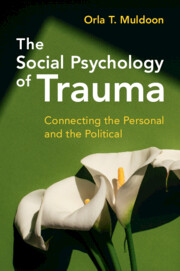Book contents
- The Social Psychology of Trauma
- The Social Psychology of Trauma
- Copyright page
- Dedication
- Contents
- Preface
- Acknowledgements
- Abbreviations
- 1 The Need for a Social Psychology of Trauma
- 2 The Cost of Trauma
- 3 Traumatic Experience Is Patterned
- 4 Theorising the Nature of Trauma
- 5 Comfort in Dark Times
- 6 Trauma, Groups and Political Action
- 7 Trauma, Personal and Political Growth and Change
- References
- Index
- References
References
Published online by Cambridge University Press: 04 April 2024
- The Social Psychology of Trauma
- The Social Psychology of Trauma
- Copyright page
- Dedication
- Contents
- Preface
- Acknowledgements
- Abbreviations
- 1 The Need for a Social Psychology of Trauma
- 2 The Cost of Trauma
- 3 Traumatic Experience Is Patterned
- 4 Theorising the Nature of Trauma
- 5 Comfort in Dark Times
- 6 Trauma, Groups and Political Action
- 7 Trauma, Personal and Political Growth and Change
- References
- Index
- References
Summary
- Type
- Chapter
- Information
- The Social Psychology of TraumaConnecting the Personal and the Political, pp. 160 - 200Publisher: Cambridge University PressPrint publication year: 2024
- Creative Commons
- This content is Open Access and distributed under the terms of the Creative Commons Attribution licence CC-BY-NC 4.0 https://creativecommons.org/cclicenses/



